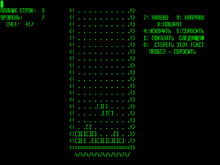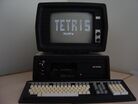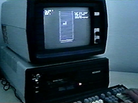Tetris (Electronika 60): Difference between revisions
m released |
MasterSushi (talk | contribs) |
||
| Line 34: | Line 34: | ||
*[http://www.youtube.com/watch?v=O0gAgQQHFcQ Video of the game running on a Soviet DVK computer, played by Sergey Frolov] | *[http://www.youtube.com/watch?v=O0gAgQQHFcQ Video of the game running on a Soviet DVK computer, played by Sergey Frolov] | ||
*[https://lab.dyne.org/OriginalTetrisHowto Original Tetris Emulation Howto] | *[https://lab.dyne.org/OriginalTetrisHowto Original Tetris Emulation Howto] | ||
*[https:// | *[https://youtu.be/8RJ_yG2RAeE Video tutorial with package link] | ||
[[Category:Official Tetris games]] | [[Category:Official Tetris games]] | ||
[[Category:Classic computer games]] | [[Category:Classic computer games]] | ||
Revision as of 09:27, 15 September 2024
| Tetris | |
|---|---|
 | |
| Developer(s) | Alexey Pajitnov |
| Platform(s) | Electronika 60 |
| Release |
|
| Gameplay info | |
| Next pieces | 1 |
| Playfield size | 10 × 20 |
| Hold piece | No |
| Hard drop | Yes |
| Rotation system | Original Rotation System |
The original Tetris ([Тетрис] Error: {{Lang-xx}}: invalid parameter: |link= (help)) was programmed by Alexey Pajitnov using the programming language Pascal on an Electronika 60 ([Электроника 60] Error: {{Lang-xx}}: invalid parameter: |link= (help)) - an unauthorized Soviet clone of a Digital Equipment Corp. PDP-11 computer. The game has monochrome graphics, and in the first revision of the game, the blocks in the tetrominos are represented by a pair of delete/rubout characters (character code 177); however, the rendering of this character code as a rectangle was a feature specific to the Soviet clone machines, an actual PDP-11 would instead display nothing. A later revision was made where the blocks are represented by a pair of square brackets instead. Pressing 1 on the keyboard will enable showing the next piece drop. In the BBC documentary Tetris: From Russia with Love, the DVK-3 computer can be seen displaying a TETRIS logo screen. It is unknown what version had this, or if it was just a mockup.
Scoring
- Points are awarded for each tetromino successfully dropped into place.
- At level 0, the potential point score for each tetromino starts at 19, and decreases by 1 every time the tetromino descends a row due to gravity. As can be seen, an I tetromino falling freely from the top of the playfield to the bottom will descend 19 rows and score 0; it is never possible to score less than 0.
- Playing at higher levels awards an additional 3 x (Level + 1) points per tetromino.
- Playing with the preview disabled awards an additional 5 points per tetromino.
- 3 digits are provided for score display; when 999 is exceeded, the counter rolls back to 0 and a tally of symbols appear in order to keep track of thousands.
Bugs
It is sometimes possible to manipulate a tetromino after performing a hard drop, even though it is supposed to be locking. Doing so will leave a trail of blocks behind, which, although visible to the player, are not recognized by the game as actually being there. This can lead to a variety of unusual scenarios, for example, visibly complete rows will not clear, and tetrominos can be dropped through the stack.
Trivia
- In Tetris The Grand Master 3 Terror-Instinct's Shirase mode, pieces turn into brackets at level 1000 to 1300.
- In Tetris Worlds (PC only), reaching rank 15 for all the Story mode games will unlock Hadar, a basic clone of this version.
- In 2023, Tetris E60, a web game released officially to promote the movie Tetris, emulating the look of the original.
- There is a theme that references this version in Tetris Effect.

